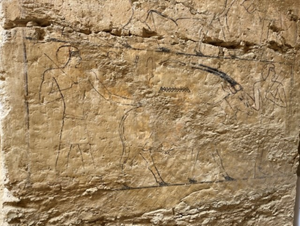
The tomb of an official responsible for secret documents in the royal chancellery during the reign of the first pharaohs of the Sixth Dynasty (c. 2300 BC) was discovered in Saqqara
The tomb of an official responsible for secret documents in the royal chancellery during the reign of the first pharaohs of the Sixth Dynasty (c. 2300 BC) was discovered in Saqqara by an expedition of the Polish Centre of Mediterranean Archaeology, the University of Warsaw.
During the autumn season of 2021, excavations were conducted within the Dry Moat that encircles the Step Pyramid complex of king Djoser, west of the tomb of vizier Merefnebef, a previous great discovery of the PCMA UW expedition. In the course of the recent research, the facade of another tomb chapel was unearthed. It is decorated with reliefs depicting the tomb’s owner. – “The dignitary bore the name Mehtjetju and was, among other things, an official with access to royal sealed, that is sacret, documents, an inspector of the royal estate and a priest of the mortuary cult of King Teti,” – explains the expedition director, Assoc. Prof. Kamil O. Kuraszkiewicz from the Faculty of Oriental Studies UW. – “This means that he most likely lived during the reigns of the first three rulers of the Sixth Dynasty: Teti, Userkare and Pepy I, and thus at about the same time as Merefnebef,” – adds the Egyptologist.
According to the discoverer, Mehtjetju’s high social position allowed him to hire skilled artisans to build the tomb, as the reliefs on the façade betray an exceptionally skilled hand, and the elegance of the lines and subtlety of the modeling rival the best reliefs in the vizier’s tomb. Unfortunately, the rock in which the chapel was carved is very brittle and eroded, so it required the immediate intervention of conservators. This task was led by the head of the conservation team, Zbigniew Godziejewski, from the National Museum in Warsaw, who passed away this year.
No polychromy is found on the façade. – “It is possible that it was never created because the decoration of the chapel was not completed. The side walls of the entrance have no relief decoration, just figures painted in black ink on lime plaster,” – says Assoc. Prof. Kuraszkiewicz. They were meant as a draft for the carving of the reliefs. The sketches depict the leading of sacrificial animals: cows, oryxes, and ibexes.
The incomplete decoration does not mean that Mehtjetju was not laid to rest in his tomb. – “If he had not been buried there, the tomb would most likely have been taken over by someone else. The decoration is unfinished probably because the investor died before the work was completed and was buried in the hastily finished tomb,” – explains the researcher.
Exploration of the interior of the chapel is planned for the fall season of 2022.

ArtDependence Magazine is an international magazine covering all spheres of contemporary art, as well as modern and classical art.
ArtDependence features the latest art news, highlighting interviews with today’s most influential artists, galleries, curators, collectors, fair directors and individuals at the axis of the arts.
The magazine also covers series of articles and reviews on critical art events, new publications and other foremost happenings in the art world.
If you would like to submit events or editorial content to ArtDependence Magazine, please feel free to reach the magazine via the contact page.